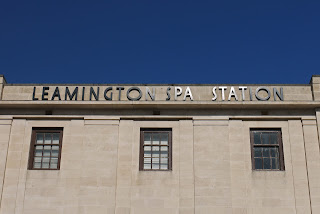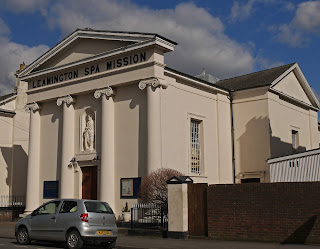All Saints church
We joined our friends Sally and Malcolm for this walk around Leamington which I found on the Discovering Britain website. The description makes it clear that Leamington was a small village until the water from its well was recognised as having medicinal qualities at the end of the 18th century. Its dominant character is Regency and Victorian and it owes it all to the spa.
The walk begins at the church of All Saints. The architect was officially a local man, J C Jackson, but the driving force was the long-serving vicar, John Craig, who is said to have been his own architect. It was begun in 1843 and the grand tower was added in 1898-1902 by Sir Arthur Blomfield. Pevsner describes it, justly, as "in a Continental Gothic style, not correct in the details". It is very big. The stained glass in the apse is lovely.
You go round the back to seek, in Church Rd, the two oldest houses in Leamington, which date from the late sixteenth or early 17th century. They are timber-framed, but have been re-fronted at a later date.
Now you return to the front of the church and turn right to cross the river and reach the Pump Rooms, with its impressive Tuscan colonade of 1813-14. Everything behind it dates from the 1920s.
The walk now takes us onto the grassy area that was once the Pump Rom Gardens. The walk guide does not comment on this handsome Italianate church on the far side.
It is St Peter's RC church, by Henry Clutton (1861-5). We cross the river again and head towards the station where our commentary focuses on the station garden. We are more taken with the stripped down classical front of the station building, with its minimalist pilasters. We enjoyed the art deco style lettering of the station name
We now walked along a short, undistinguished, section of the Grand Union Canal and emerged near the Apollo Rooms, once one of seven competing pump rooms. It operated under the wonderful name of Smart’s Imperial Sulphurous Medicinal Fount and Ladies Marble Baths. There was too much traffic unfortunately to permit a photo.
Not much further on, we reached the Leamington Spa Mission in George St. This was built in 1828 as a Roman Catholic chapel, the first in the town. It eventually fell into disuse, but was taken over by the Seventh Day Adventists in the 1990s and restored.
We crossed the river for the third time by the blue suspension bridge to enter Jephson Gardens, named for the town's most famous doctor and an advocate of taking the waters. Our walk guide had explained that the delightful prevalence of public open space by the river was the result of it being on the flood plain. It does give this part of the town a pleasant spacious character.
In the gardens there is a tiny, rather unconvincing Clock Tower, a nice little tempietto providing a monument to Jephson and a fine new hothouse.
After a break for lunch, we walked up Regent Grove, a wide spacious road with a grassy central area and a path up the middle. We were now entering the "new town" of Leamington, developed after the Spa boom started to take off - the original village was to the south of the river. The new town was planned mainly on a grid pattern, but with some curves to give it a more rural feel.
On the right, Hamilton Terrace, was lovely brick chapel of a rather unusual design. It is now offices. It is not mentioned in Pevsner, but some Googling reveals it was the Congregational Church and dates from 1849.
At the top we found our way to Lansdowne Circus, a group of semi-detached villas laid around a circular communal garden. It lacks the sheer grandeur of the Circus in Bath, but the houses with their balconies and wrought ironwork make a lovely group. Pevsner describes them as "sweet cottages". It is interesting that they are actually built of brick and faced with stucco. The Circus was the work of W Thomas. It is apparently one of the best addresses in Leamington.
Round the corner is Lansdowne Crescent, a classic terraced Crescent, again with fine ironwork.
We now passed the lowest point of the walk: the Chandos St car park. This was an unlovely parking lot which forms one block of the grid system, and might be redeveloped. This just crystallised our feeling that the author of the walk description was slightly too fascinated with every detail of his home town.
We had now sadly run out of time (our Italian evening class beckoned) and we forwent a visit to Clarendon Square, built on three sides with substantial houses of 1825. Instead we walked down The Parade, a wide impressive thoroughfare of about the same age.
At the bottom, after the Regent Hotel, once one of the largest in Europe and now a Travel Lodge, you come to the Town Hall, which marks the end of the walk. It dates from 1884-5 and is by J Cundall. It is an impressive building, but as Pevsner says "quite out of keeping with Leamington".
Conditions: bright, but quite cold.
Distance: about 3 miles.
Rating: three and half stars.












No comments:
Post a Comment